Edge in Nick Castellanos’ game was there as a teen when he was cut from Bryce Harper’s national team
The fire the Phillies like in their new slugger was evident when he returned the next year showing the kind of "passion" Harper wants on his team.

The fire the Phillies like in their new slugger was evident when he returned the next year showing the kind of "passion" Harper wants on his team.
